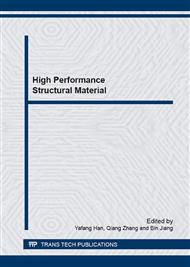[1]
J. Geng, P. Tsakiropoulos, G. Shao, A study of the effects of Hf and Sn additions on the microstructure of Nbss/Nb5Si3 based in situ composites, Intermetallics. 15(2007) 69-76.
DOI: 10.1016/j.intermet.2006.03.001
Google Scholar
[2]
W. Li, H. Yang, A. Shan, L. Zhang, J. Wu, Effect of Mo addition on the phase stability of β-Nb5Si3 phase, Intermetallics. 14(2006) 392-395.
DOI: 10.1016/j.intermet.2005.07.001
Google Scholar
[3]
B.P. Bewlay, M.R. Jackson, J.C. Zhao, P.R. Subramanian, A review of very-high-temperature Nb-silicide-based composites, Metall. Mater. Trans. A. 34 (2003) 2043-(2052).
DOI: 10.1007/s11661-003-0269-8
Google Scholar
[4]
B.P. Bewlay, M.R. Jackson, H.A. Lipsitt, The Balance of Mechanical and Environmental Properties of a Multielement Niobium-Niobium Silicide-based in situ Composite, Metall. Mater. Trans. A. 27(1996) 3801-3808.
DOI: 10.1007/bf02595629
Google Scholar
[5]
M.G. Mendiratta, D.M. Dimiduk, Strength and toughness of a Nb/Nb5Si3 composite, Metall. Mater. Trans. A. 24(1993) 501-504.
DOI: 10.1007/bf02657338
Google Scholar
[6]
X. Li, H. Chen, J. Sha, et al., The effects of melting technologies on the microstructures and properties of Nb-16Si-22Ti-2Al-2Hf-17Cr alloy, Mater. Sci. Engng. A. 23(2010) 6140-6152.
DOI: 10.1016/j.msea.2010.04.046
Google Scholar
[7]
A. Kostov, B. Friedrich, Predicting thermodynamic stability of crucible oxides in molten titanium and titanium alloys, Comp. Mater. Sci. 38(2006) 374-385.
DOI: 10.1016/j.commatsci.2006.03.006
Google Scholar
[8]
L.M. Ma, S.N. Yuan, R.J. Cui, et al. Interactions between Nb-silicide based alloy and yttria mould during directional solidification, Int. J. Refract. Met. Hard. Mater. 30(2012) 96-101.
DOI: 10.1016/j.ijrmhm.2011.07.009
Google Scholar
[9]
O. Fabrichnaya, C. Mercer, Phase relations in the HfO2-Y2O3-Al2O3 system, Comp. Coupling. Phase Diag. Thermo. Chem. 29(2005) 239-246.
DOI: 10.1016/j.calphad.2005.07.003
Google Scholar
[10]
L. Ma, X. Tang, B. Wang, et al. Purification in interaction between yttria mould and Nb-silicide based alloy during directional solidification: A novel effect of yttrium, Scripta Materialia. 3(2012) 233-236.
DOI: 10.1016/j.scriptamat.2012.04.025
Google Scholar
[11]
I. Barin, Thermochemical data of pure substances, 3rd ed., Wiley-VCH, Weinheim, (1997).
Google Scholar
[12]
R. Dicks, F. Wang, X. Wu, The manufacture of a niobium/niobium-silicide-based alloy using direct laser fabrication, J. Mater. Process Technol. 209(2009) 1752-1757.
DOI: 10.1016/j.jmatprotec.2008.04.042
Google Scholar
[13]
J.L. Murray, H.A. Wriedt, The O-Ti (Oxygen-Titanium) System, Bull. Alloy Phase Diag. 8(1987) 148-165.
Google Scholar
[14]
J. Zhu, A. Kamiya, T. Yamada, Surface tension, wettability and reactivity of molten titanium in Ti/yttria-stabilized zirconia system, Mater. Sci. Engng. 327(2002) 117-127.
DOI: 10.1016/s0921-5093(01)01732-4
Google Scholar
[15]
A.V. Kartavykh, V.V. Tcherdyntsev, J. Zollinger, TiAl-Nb melt interaction with AlN refractory crucibles, Mater. Chem. Phys. 116(2009) 300-304.
DOI: 10.1016/j.matchemphys.2009.03.032
Google Scholar
[16]
A.V. Kartavykh, V.V. Tcherdyntsev, J. Zollinger, TiAl-Nb melt interaction with pyrolytic boron nitride crucibles, Mater. Chem. Phys. 119(2010) 347-350.
DOI: 10.1016/j.matchemphys.2009.09.021
Google Scholar


